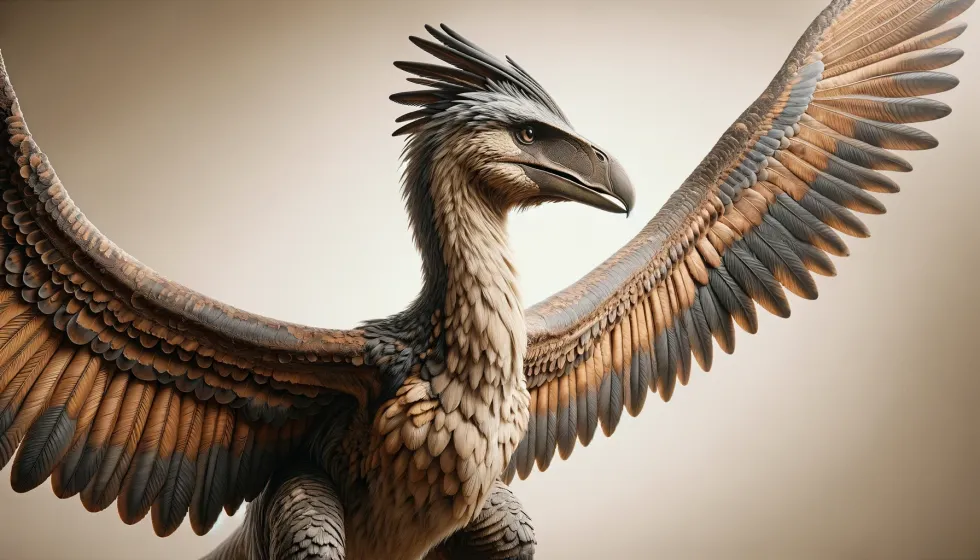The Argentavis magnificens, a name that resonates with impressiveness and evokes images of an untamed prehistoric world, once glided majestically through the skies of South America. As one of the largest flying birds that ever lived, its existence has been a source of intrigue and wonder within the scientific community and the curious public.
The discovery of its fossils has been instrumental in shaping the understanding of the natural history of birds, offering a rare glimpse into the lives of creatures that lived millions of years before humans walked the Earth.
Despite its huge size, it was able to fly with ease due to the strong thermal updrafts in the Andean foothills. Its dominance in the air during the Late Miocene Era (approximately 6-9 million years ago) was unparalleled and is thought to have been an active predator.
Argentavis Interesting Facts
How do you pronounce 'Argentavis'?
It's pronounced as 'ahr-jen-TAY-vis'.
What type of animal was it?
Although not a dinosaur, Argentavis was a member of the prehistoric birds, specifically the Teratornithidae family, known for their large size and powerful flying abilities.
In which geological period did this animal roam the Earth?
It roamed the Earth during the Late Miocene Period (about 6-9 million years ago), which is part of the Neogene Period (23-2.6 million years ago).
When did the Argentavis become extinct?
The exact extinction time is unknown, but it's believed that Argentavis became extinct around 5-6 million years ago at the end of the Miocene Epoch (23-5.3 million years ago).
Further paleontological research may eventually provide more information on this.
Where did this animal live?
This massive flying bird lived in what's now known as South America, particularly in the open habitats and Andean foothills in central and northwestern Argentina.
What was their habitat?
The habitat of Argentavis consisted of open grasslands and sparse forests, which provided the necessary wind currents for its gliding and soaring flight.
Who did they live with?

Argentavis likely shared its habitat with a variety of other animals, including other teratorns and smaller creatures it preyed upon.
How long did this animal live?
While the lifespan is not definitively known, large birds generally have longer life spans, and it's possible Argentavis lived for several decades.
How did they reproduce?

Drawing from the reproductive patterns of similar species, it is believed that Argentavis magnificens typically laid one or two eggs around once every two years.
Argentavis Fun Facts
What did they look like?
The Argentavis had a body mass far exceeding that of modern birds, featuring a massive body and a wide wingspan ranging from 16.7-21.3 ft (5.1-6.5 m).
Its body was robust, and it employed flapping flight occasionally, which was supplemented by soaring on thermal updrafts.
How many bones did an Argentavis have?

The number of bones in Argentavis is not precisely known, but it would have had a skeletal structure supporting its large size and wing area for flight.
How did they communicate?
The specific communication methods of the Argentavis magnificens are not known. It's speculated that the Argentavis, like many birds, used vocalizations and body language to communicate, especially during mating rituals or territorial disputes.
How big was the Argentavis?
With its giant wings and significant body mass, the Argentavis stood out as a large bird, dwarfing even the Andean condor, one of the largest birds capable of flight today.
How fast could this animal move?
Estimates suggest that, despite its size, the Argentavis could achieve decent speeds in flight, especially when aided by strong wind speeds.
How much did an Argentavis weigh?
The Argentavis weighed around 154-159 lb (70-72 kg), making it the heaviest flying bird ever.
What were the male and female names of the species?

There are no specific terms for male or female Argentavis. They were identified by their species name, in this case, Argentavis magnificens.
What would you call a baby Argentavis?
A baby Argentavis might be termed a chick, as with other birds.
How aggressive were they?

Though the Argentavis magnificens might have shown aggression while fighting for food or during mating, it likely behaved more as a scavenger than a hunter. Its aggression would have varied based on food scarcity and competition.
Did you know...
In the video game 'ARK: Survival Evolved', players can use an Argentavis saddle to ride these majestic creatures. This portrayal captures the imagination of how it might have been to interact with such an incredible bird.
FAQs
Why did Argentavis go extinct?
Like many prehistoric species, the extinction of the Argentavis is a subject of ongoing study and debate among paleontologists. As South America's landscapes transformed, becoming more forested and less open, the strong thermal updrafts that the Argentavis depended upon for soaring became less prevalent.
These environmental shifts would have made it harder for these giants to find the required air currents to stay aloft and cover the long distances they were adapted to fly.
Moreover, changes in habitat would have affected the availability of prey animals. As active predators, Argentavis would have relied on a plentiful supply of medium-sized mammals to sustain their large body mass. With their prey becoming scarcer due to environmental changes or competition with other predators, the Argentavis faced a significant survival challenge.
While specific causes are difficult to pinpoint due to the lack of direct evidence from fossil records, the combination of climate change, habitat loss, and food scarcity provides a plausible explanation for why these magnificent birds, who once ruled the skies, were ultimately grounded and pushed to extinction.
Is Argentavis the biggest bird ever?
Argentavis magnificens, often called 'giant teratorn', was among the largest known flying birds. It boasted an impressive wingspan ranging from 16.7-21.3 ft (5.1-6.5 m) and a substantial weight estimated at approximately 154-159 lb (70-72 kg), making it one of the most sizable birds to have ever taken to the skies.
While Argentavis is a prime candidate for the title of the largest flying bird, it is not without competition from other prehistoric species. Notably, Pelagornis sandersi is recognized for its remarkable wingspan, which is believed to have been approximately 19.9-24.2 ft (6.1-7.4 m), potentially exceeding that of Argentavis.
On the ground, the extinct flightless birds, known as the Elephant Bird from Madagascar and the Moa from New Zealand, were larger in overall body size but lacked the capability for flight. In contrast, the Argentavis excelled in the skies with adaptations that enabled it to stay aloft, utilizing thermal currents to glide over vast tracts of land.
Hence, although the Argentavis is undeniably among the largest avian species ever recorded and is renowned for being one of the most sizable birds capable of flight, according to fossil records, it does not hold the title of the largest bird in history when taking both flying and non-flying species into account.
Could a human ride an Argentavis?
From a purely factual standpoint, it is highly unlikely that a human could have ridden an Argentavis. Even though the Argentavis magnificens was an enormous bird with a considerable size and weight-carrying capacity, there is no evidence to suggest that it could have supported the additional weight of a human rider.
The skeletal structure and musculature of flying birds are finely tuned for their body weight and the physics of flight. Any significant additional weight could disrupt their ability to take off, fly, or land safely. Additionally, the behavior and habitat of the Argentavis, as understood from fossil records, does not indicate any interaction with humans, given that they existed several million years before humans appeared on Earth.
The idea of riding an Argentavis likely stems from the realm of fiction and popular media, such as the video game 'ARK: Survival Evolved', where players can tame and ride these creatures.
While this concept is an entertaining aspect of the game and sparks the imagination, in reality, the biology and time of the Argentavis make the notion of a human riding one impossible.
What was the largest bird that ever lived?
Identifying the largest bird that ever lived depends on the criteria used, whether it is the largest in height, weight, wingspan, or the ability to fly. Argentavis magnificens is one of the largest flying birds ever discovered; however, it is not the heaviest flying bird of all time. Pelagornis sandersi is another extinct bird known for having the largest wingspan of any bird, estimated to be approximately 19.9-24.2 ft (6.1-7.4 m).
When considering flightless birds, the Elephant Bird (Aepyornis maximus) of Madagascar, also known as Vorombe titan, is believed to have been the heaviest, with estimates of its weight reaching up to 1,870 lb (850 kg). The South Island giant moa (Dinornis robustus) from New Zealand was another large flightless bird that reached heights of approximately 12 ft (3.6 m) and weighed about 510 lb (230 kg).
While Argentavis magnificens was an exceptionally large and heavy flying bird, it is not the heaviest bird ever, as that title likely belongs to the flightless Elephant Bird. Pelagornis sandersi holds the record for the largest wingspan among birds.
The Argentavis magnificens was a remarkable species of prehistoric life renowned for its impressive size and exceptional flight capabilities. Due to its magnificence and diversity, it has become legendary among scholars and enthusiasts alike.
Despite the many unknowns about the Argentavis, ongoing research continues to enhance the understanding of its existence, predation habits, and the role it played in the ecosystems of Miocene South America. This ancient bird symbolizes the mastery of flight achieved by creatures long before the advent of human aviation.
Related Articles Around the Web














